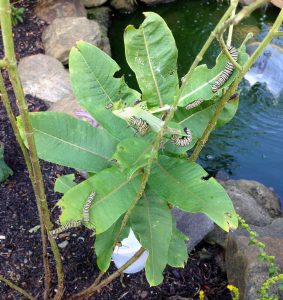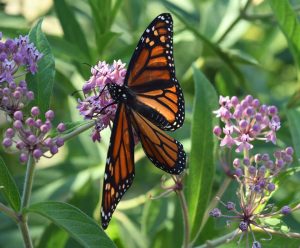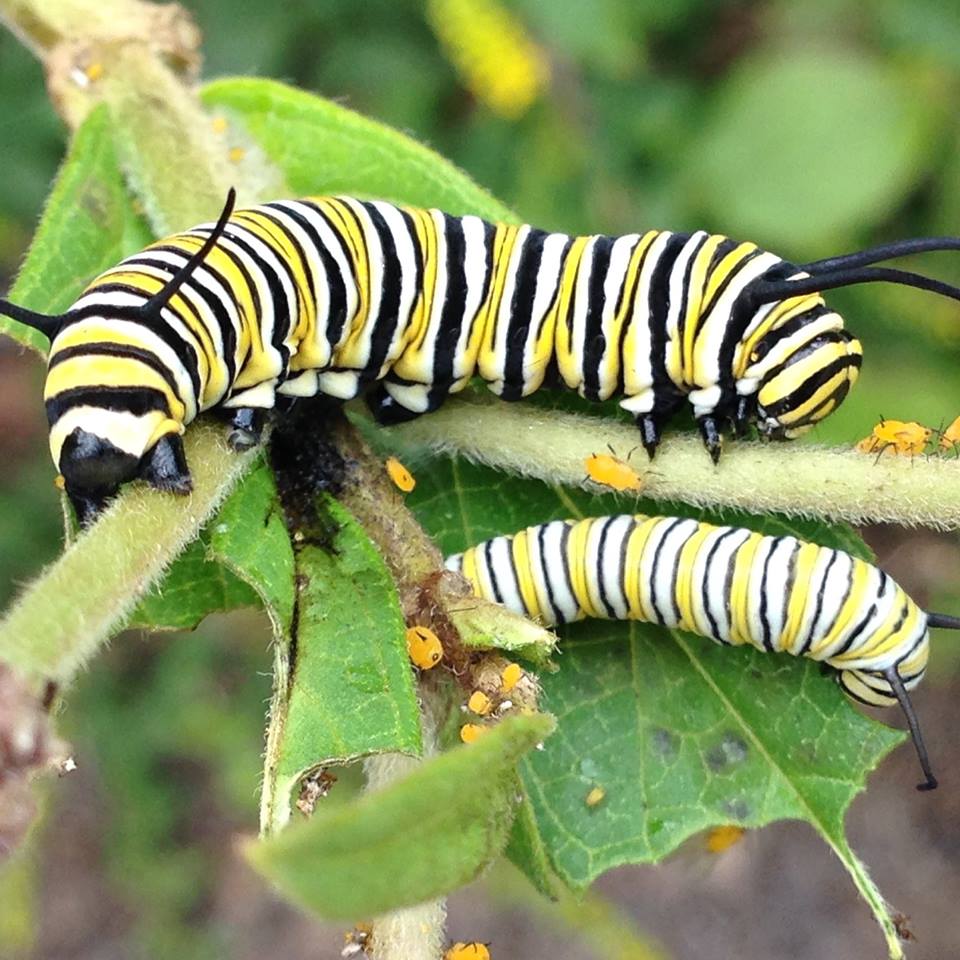(By Laura Lee Cascada / Photos by Alysoun Mahoney)
These caterpillars sure are hungry. And they’ve struck gold, munching their way through an all-you-can-eat milkweed buffet. But many others aren’t so lucky.
On a beautiful plot of land in Virginia, these two were seen plumping themselves up, preparing to blossom into the striking orange-and-black butterflies we know as monarchs. And after emerging in adult form, they, along with tens of millions of others, are likely embarking on a long flight down to Mexico this month. Monarchs, the only species of butterfly that completes a round-trip migration like birds do, use air currents and thermals to navigate the arduous journey. In Mexico, among forests of oyamel fir trees, they will spend winter, conserving their energy for the long migration–often thousands of miles–back home to the eastern United States in early spring so that they can lay their eggs.
If they can lay their eggs.
This summer, the Chicago Tribune reported that monarch butterfly populations were continuing to spiral downward, as they have for the last 20 years. And Karen Oberhauser, co-chair of Monarch Joint Venture and a University of Minnesota professor, noted that this year’s monarch numbers seemed to be only half those of last year. But why?
 There simply isn’t enough milkweed to go around. Milkweed provides crucial nutrition for growing larvae–caterpillars–and it’s the only plant on which female monarchs can lay their eggs. Without it, monarchs are doomed.
There simply isn’t enough milkweed to go around. Milkweed provides crucial nutrition for growing larvae–caterpillars–and it’s the only plant on which female monarchs can lay their eggs. Without it, monarchs are doomed.
Since the mid-1990s, according to the U.S. Department of Agriculture, the use of herbicide-tolerant soy and corn crops has grown so much that they now comprise nearly 90 percent of all agricultural area. With the increase in such crops comes greater herbicide use by farmers, in turn decimating milkweed plants that had taken root between endless rows of cornstalks.
So it’s no surprise that area of the winter safe haven occupied by monarchs has been shrinking since the mid-1990s, as well–once at 45 acres, and in 2014, not even 3 acres, according to the World Wildlife Fund.
But a growing movement of monarch enthusiasts is working hard to buck this trend, creating vital milkweed habitat for the vibrant butterflies. In 2013, as part of this national effort, Virginia resident Alysoun Mahoney–whose home has provided refuge over the years for dogs, cats, and even her three rescued horses–started planting milkweed around her property. The monarchs immediately took advantage of the open-house invitation and moved right in.
This year, Alysoun reported seeing a female monarch each day for 10 consecutive days in August on a single cluster of milkweed plants right outside her kitchen window. Later in the month, there were dozens of eggs and even some caterpillars. By September, there were dozens of caterpillars, who then demolished the leaves on those plants. Alas, a food shortage seemed inevitable.
 Alysoun notes that generally, she prefers to “provide appropriate habitat and then let Mother Nature take over from there.” But this time, she “couldn’t help but tinker with Mother Nature just a tiny bit.” She quickly cut some milkweed stalks from a nearby field and watched as the caterpillars took over their new food supply within a matter of hours.
Alysoun notes that generally, she prefers to “provide appropriate habitat and then let Mother Nature take over from there.” But this time, she “couldn’t help but tinker with Mother Nature just a tiny bit.” She quickly cut some milkweed stalks from a nearby field and watched as the caterpillars took over their new food supply within a matter of hours.
So Alysoun continued looking after them for several days, replenishing their milkweed meals as needed until they entered the pupal stage, just days or weeks away from metamorphosing into full-fledged monarch butterflies.
Now, with Mexico on the horizon, we bid these–and millions of other–young monarchs bon voyage and farewell, and hope that when they return, they’ll be met with fields abounding with milkweed. You can help these majestic butterflies complete their journey and bring the next generation of monarchs into the world by planting milkweed in your own community.*
*If you have companion animals, please use caution in selecting locations to plant your milkweed, as it can be quite toxic if ingested.


